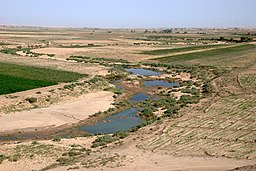Habur River
| Khabur | |
| Arabic: نهر الخابور, Aramaic:ܢܗܪܐ ܕܚܒܘܪ, Kurdish: Çemê Xabûr, Turkish: Habur Nehri, Habor, Chaboras, Hebrew: Kebar, Chebar | |
| river | |
|
Khabur south of Al-Hasakah
|
|
| Countries | Syria, Turkey |
|---|---|
| City | Ra's al-'Ayn, Al-Hasakah, Busayrah |
| Source | Ras al-Ayn |
| - elevation | 350 m (1,148 ft) |
| Mouth | Euphrates |
| - coordinates | 35°8′33″N 40°25′51″E / 35.14250°N 40.43083°ECoordinates: 35°8′33″N 40°25′51″E / 35.14250°N 40.43083°E |
| Length | 486 km (302 mi) |
| Basin | 37,081 km2 (14,317 sq mi) |
| Discharge | |
| - average | 45 m3/s (1,589 cu ft/s) |
| - max | 57 m3/s (2,013 cu ft/s) |
| - min | 2 m3/s (71 cu ft/s) |
The Khabur River (Arabic: الخابور al-khābūr, Kurdish: Xabûr, Syriac: ܚܒܘܪ ḥābur/khābur, Turkish: Habur) is the largest perennial tributary to the Euphrates in Syrian territory. Although the Khabur originates in Turkey, the karstic springs around Ra's al-'Ayn are the river's main source of water. Several important wadis join the Khabur north of Al-Hasakah, together creating what is known as the Khabur Triangle, or Upper Khabur area. From north to south, annual rainfall in the Khabur basin decreases from over 400 mm to less than 200 mm, making the river a vital water source for agriculture throughout history. The Khabur joins the Euphrates near the town of Busayrah.
The course of the Khabur can be divided in two distinct zones: the Upper Khabur area or Khabur Triangle north of Al-Hasakah, and the Middle and Lower Khabur between Al-Hasakah and Busayrah.
The tributaries to the Khabur are listed from east to west. Most of these wadis only carry water for part of the year.
Since the 1930s, numerous archaeological excavations and surveys have been carried out in the Khabur Valley, indicating that the region has been occupied since the Lower Palaeolithic period. Important sites that have been excavated include Tell Halaf, Tell Brak, Tell Leilan, Tell Mashnaqa, Tell Mozan and Tell Barri. The region has given its name to a distinctive painted ware found in northern Mesopotamia and Syria in the early 2nd millennium BCE, called Khabur ware. The region of the Khabur River is also associated with the rise of the Kingdom of the Mitanni that flourished c.1500-1300 BC.
...
Wikipedia

